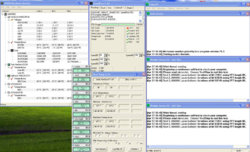- Joined
- Jul 18, 2007
- Messages
- 813 (0.12/day)
- Location
- Almonte, Canada
| System Name | Sonny Boy |
|---|---|
| Processor | i5 11600K 4.9GHz @ 1.35 Vcore |
| Motherboard | AORUS Z590 Elite AX |
| Cooling | Deepcool Gammix 240mm AIO |
| Memory | 4 X 8GB Teamgroup DDR4 3200MHz |
| Video Card(s) | ASUS RTX 3060 Ti GDDR6X |
| Storage | Adata Legend 1TB |
| Display(s) | Philips 27" 4K |
| Power Supply | Corsair 750W |
| Mouse | Razer Basilisk |
| Keyboard | Razer Huntsman V2 |
| Software | Windows 11 Pro |
For some time I have been using Speedfan, Coretemp, RealTemp, and ASUS Probe to measure my CPU temperatures. Since Speedfan, Coretemp, and RealTemp all seemed to agree on precisely the same core temperatures I assumed everything was rosey. ASUS Probe doesn't report core temperatures... just the "CPU" temperature.
Well my "CPU" temperature as reported in my BIOS, Speedfan, and ASUS Probe has always been about 8C hotter than my cores which is ridiculous since nothing should be hotter than the silicon itself. So I just assumed that the CPU temperature was messed up.
Now I am starting to question this. Let me explain...
I have always trusted CPUZ as an excellent tool to display my CPU and memory information. I noticed that they (CPUID) had a new tool called CPUID Hardware Monitor so I thought I would give it a whirl. What I discovered was that it displayed the "CPU" temperature the same as BIOS/Speedfan/ASUSProbe but it had a whole new take on the Core temperatures. In fact it made sense if the CPU temp was supposed to be Tcase since the cores were then about 7C hotter than the case.
So now I am asking myself... I have been assuming all along that the core temperatures were correct and the "CPU" temp was screwed up... Could it be that the CPU temp is indeed correct and it is the core temps that are off?
See my screenshot below. Anyone know how CPUID is getting their core temps and why it is so different from the other tools?

Well my "CPU" temperature as reported in my BIOS, Speedfan, and ASUS Probe has always been about 8C hotter than my cores which is ridiculous since nothing should be hotter than the silicon itself. So I just assumed that the CPU temperature was messed up.
Now I am starting to question this. Let me explain...
I have always trusted CPUZ as an excellent tool to display my CPU and memory information. I noticed that they (CPUID) had a new tool called CPUID Hardware Monitor so I thought I would give it a whirl. What I discovered was that it displayed the "CPU" temperature the same as BIOS/Speedfan/ASUSProbe but it had a whole new take on the Core temperatures. In fact it made sense if the CPU temp was supposed to be Tcase since the cores were then about 7C hotter than the case.
So now I am asking myself... I have been assuming all along that the core temperatures were correct and the "CPU" temp was screwed up... Could it be that the CPU temp is indeed correct and it is the core temps that are off?
See my screenshot below. Anyone know how CPUID is getting their core temps and why it is so different from the other tools?






